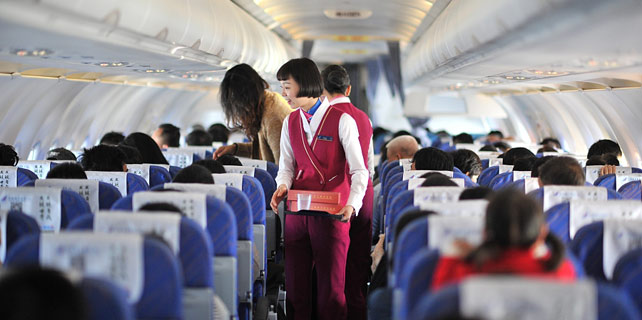Trains in China on faster track with ability, ambition
 |
|
A Fuxing train is seen at the Shijiazhuang Railway Station in Shijiazhuang, Hebei province, Aug 21, 2017. [Photo/Xinhua] |
SHANGHAI - Starting Sept 21, China will have the world's fastest bullet trains.
The domestically developed trains running between Beijing and Shanghai, called the Fuxing (meaning "rejuvenation" in Chinese), show that China, which has started late on the high-speed track, is cementing its leading role in the race.
The new trains run at a consistent speed of 350 km per hour, cutting travel time to 4.5 from 5 hours on China's busiest rail line. At that speed, the current train ride from London to Paris of two hours and 16 minutes could be half an hour shorter.
With free Wi-Fi and more power outlets, USB ports and legroom, Fuxing is more comfortable to ride in. It is safe, too, said Zhang Bo, researcher with the Locomotive and Car Research Institute of China Academy of Railway Sciences (CARS).
China has paid scrupulous attention to safety in developing its high-speed railway, Zhang said.
The train contains more than 2,500 sensors -- 500 more than previous models -- to simultaneously collect some 1,500 real-time indicators from all carriages. Alarms are activated if an abnormality occurs in the cooling, braking or air-conditioning systems. If necessary, the train will slow or stop on its own.
To avoid damage to carriages and fatalities, new trains are armed with more advanced shock and crash energy absorption equipment.
Devices in the fairing can absorb energy equivalent to lifting a 210-tonne object one meter, said Zhang.
The Fuxing can serve for 30 years, 10 years more than the existing model, and consumes 10 percent less power when running at 350 km per hour.
"Fuxing puts China on a higher stage," said Sun Zhang, professor at Shanghai Tongji University.
For over a decade, China has learned from developed countries to build a world-class high-speed railway system. Now it holds the complete intellectual property rights for Fuxing, which is designed and manufactured without help from the West.
However, this does not mean that parts for the trains cannot be imported.
"It is common practice in the industry to buy certain components and parts best produced by a country in such a globalized market," said Sun, a specialist in transportation planning and management.
For instance, many train makers worldwide purchase insulated gate bipolar transistors from French producers, while China's buffers and chain couplers are also used by foreign producers due to their reliability, Sun said.
Though it was a latecomer, China now has the world's greatest high-speed rail network -- 22,000 kilometers as of the end of 2016, or about 60 percent of the world's total.
Indeed, China is endowed with an advantage in developing bullet trains. Its diversity of geological, climate and even air conditions push Chinese engineers to break boundaries and achieve technological breakthroughs.
Railroads are laid in subtropical and frigid zones in China, on loess land, soft soil and lava areas, along the coast and in the highland. Now China is building the Sichuan-Tibet railway, which will climb from the Sichuan Basin to the Roof of the World, at an elevation of more than 4,400 meters above sea level.
More than 80 percent of the line will be tunnels and bridges, avoiding snowy mountains and rivers.
Such demanding tasks have made Chinese engineers and builders more experienced and Chinese-manufactured trains more reliable and compatible, said Sun.
The Fuxing trains are able to run in extreme temperatures of minus 40 degrees Celsius and 40 degrees Celsius and can be adapted to various geological and operational situations, said He Huawu, chief engineer of China Railway Corp.
Fuxing will be China's main high-speed rail export in the future, and Made-in-China trains have already made their way to countries like Indonesia, Russia, Iran and India.
Experts, including Professor Sun, are confident that the new model will be welcomed in many countries, especially in Asia, Europe and Africa.
To meet international demand, China will work ceaselessly to make the high-speed rail system more intelligent in terms of safety, maintenance, comfortability, and for technical upgrades.
Interconnectivity should also be taken into consideration, as the train system may be used overseas, Sun said.






















